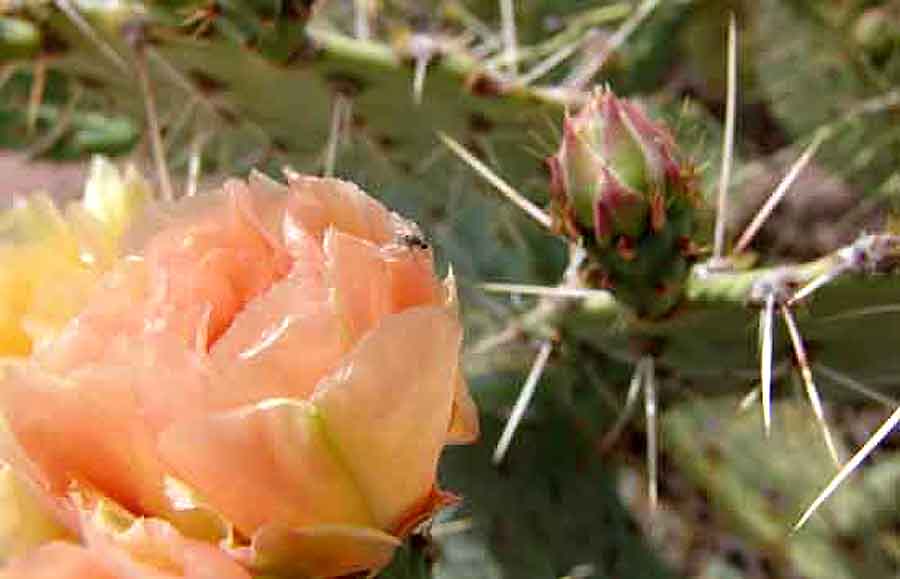Prickly Pear (Platyopuntia species)
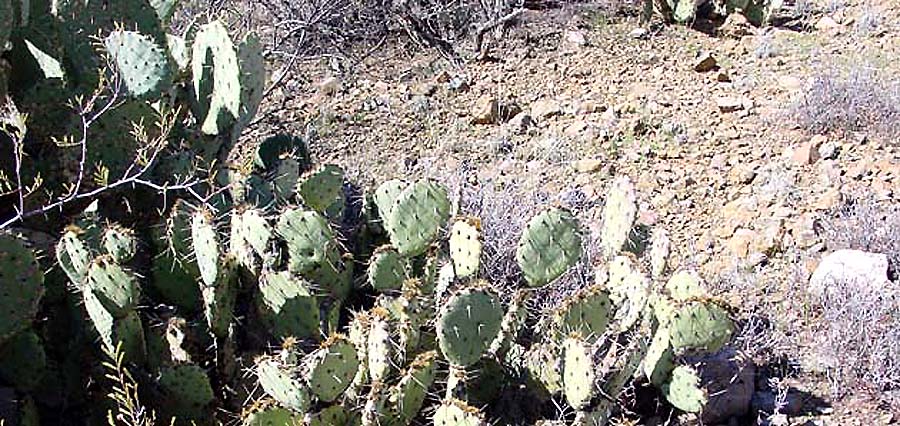
Large, strongly flattened-jointed stems distinguish this genus from its (also glochid-bearing) sisters, the cylindrical-stemmed Chollas. The trunk, when present, and main and minor branches are all composed of these flattened joints, which grow to a predetermined size, when the terminal bud ceases further growth. While some 27 species grow in the United States, only two are found in our area (and they interbreed in some places -- indeed they are considered one species by some writers). Though various writers seem to disagree on names, species, and varieties, we (lacking the sophistication to deal with the taxonomic complexities here) think that we have anyway two different forms appearing in our area. The photograph above shows both of them: in the lower left to right foreground of the photo, you see a lower-height cluster, with greater abundance of reddish-brown glochids on the sides, and in the upper left edge of the photo you see a taller cluster, with less reddish edging and larger, flatter stems. We will call these two forms here by the following names:
Opuntia engelmannii
Common or abundant throughout Arizona and beyond (and ranging from 1,500 to 5,000 feet), this is a very robust form. Its stems range from almost circular to rhomboid in shape (and up to more than a foot across), and some mature plants attain heights of nearly 9 feet, often forming a sort of round-topped cone in overall shape. The stems are green to bluish green in color, spines are gray to white and up to 3" long. Areoles have brown to yellowish glochids. Flowers, blooming from April to June, form along the edges of pads, are yellow to orange in color, yielding red to purple cylindrical fruit up to 3" long.
In the photo below left, you see some of the rhomboid forms as well as the overall shape of the whole plant, which is much taller than O. phaeacantha. Below right, you see an edge less thick with reddish-brown glochids and also a pad whose overall color is a paler blue-green, with hardly a hint of purple or red.
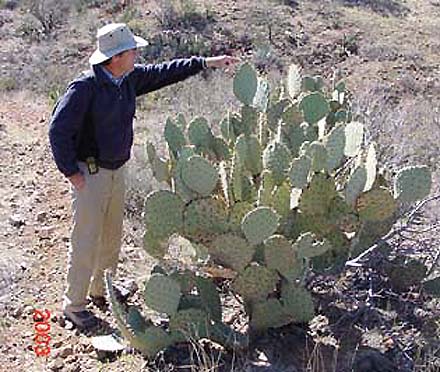 ..
..
Opuntia phaeacantha
In this type of Prickly Pear, you see, below left, a much lower-running plant overall, and a thicker array of reddish-brown glochids along the edges. Note also the hints of purplish color along the edges, contrasting with the green. Below right, this purplish color is evident not only along the edges but around the rims of the areoles. Note also in this picture the reddish new ephemeral leaves appearing with the buds. Photos were taken in March of 2003.
 ..
..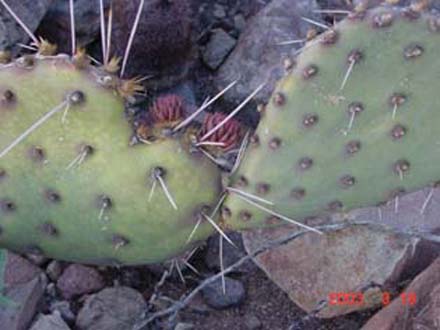
The stems of O. phaeacantha turn a fairly bright purple-to-red color during drier periods -- the above photos were taken shortly after rains. This reddening does not occur with the "Engelmannii" variety: compare the two kinds under stress -- the Phaeacantha below left, the Engelmannii on the right:
 ..
..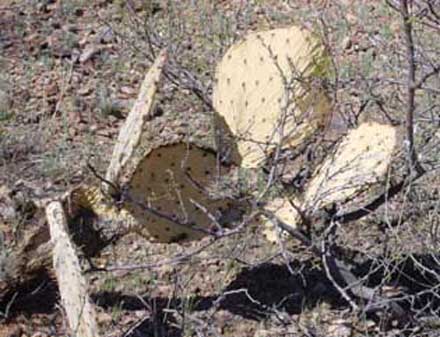
For an apparently similar contrast drawn between these two types of Prickly Pear, see the following link to Mineral Arts -- where the Phaeacantha variety is labeled as "Brownspine Prickly Pear".
Both kinds produce yellowish flowers, but the two are somewhat different in size and tone. Below left: O. engelmannii blossoms, which tend to be larger, mainly pure yellow (though they also show pale pink, as in the photo at the very top of the page), and open to a flatter cup; below right: phaeacantha blossoms are smaller, have definite reddish streaks toward the base, and do not open as widely. Remember that these differences seem to blur out in the wild to some extent. (Click on each image to enlarge it.)
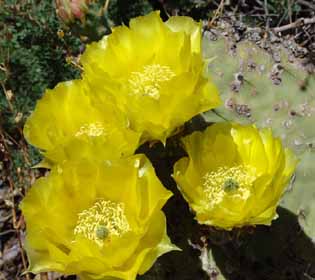 ..
..
Both types are visited by a wide array of pollinators, diverse beetles, solitary bees, and european honeybees. In the image below left, a solitary bee wallows alone; below right, numerous tiny beetles are busy.
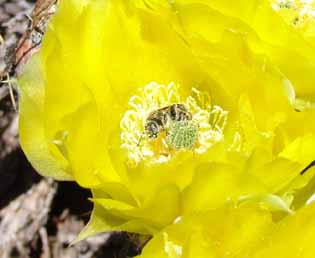 ..
..
Both types ripen into fleshy fruits that are edible and sweet-tasting (but which contain glochids in the rind). Humans use the juice to make jellies. For more details on Prickly Pear harvesting and processing, see this link: Daniel Baker's Wildfoods Logbook.
Mark Dimmit (p.218 in Phillips & Comus, cited on the main Cacti page) observes that the Engelmannii fruits, called "tunas" -- which ripen in tremendous abundance and persist on the plants for months -- are both far too numerous and many stand too high and remote from the ground for the small creatures of our Sonoran Desert to consume most of the fruits. This poses an evolutionary-ecological problem: why such a waste of bio-energy in overproduction of fruits, most of which eventually decay and shrivel uneaten? Dimmit suggests it seems likely that Opuntia engelmannii Prickly Pears coevolved with the now-extinct Megafauna of the Pleistocene Southwest, which could consume this highly nutritious crop and act as efficient agents of seed dispersal. Their extinction left the Engelmann Opuntia fruits standing "high and dry", so to speak. In the recent past, of course, cattle -- and also horses -- have arrived to play this role, as is evident in the great proliferation of O. engelmannii in many of our desert uplands today. Below: Opuntia engelmannii fruit ripening. The fruit of O. phaeacantha are much smaller.
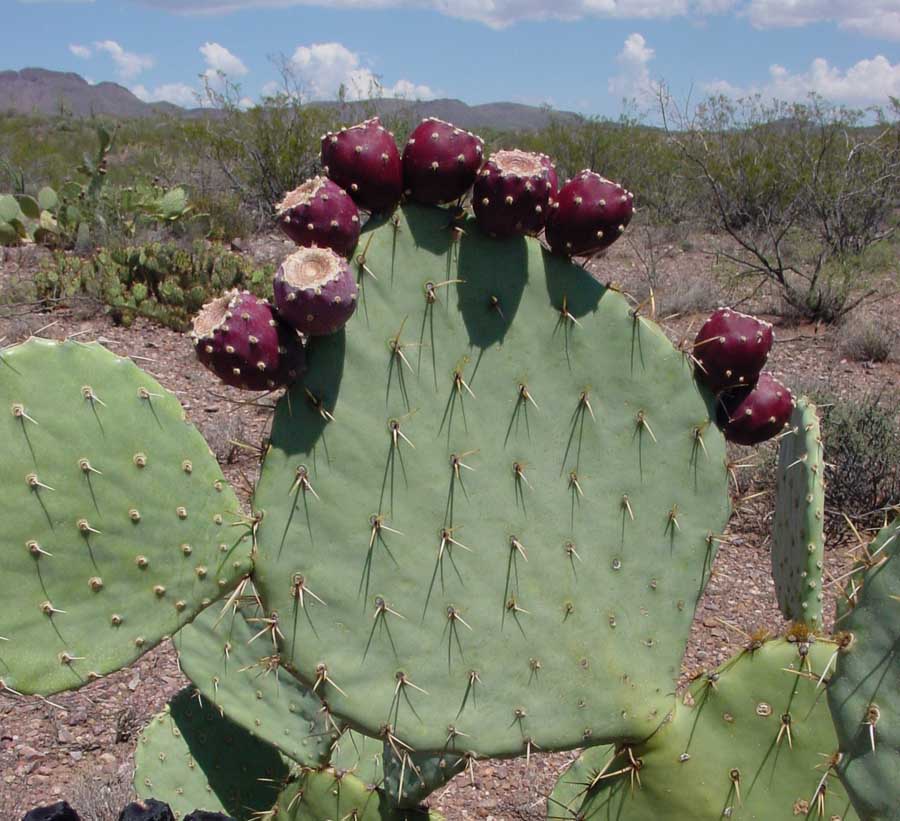
The story is told by some of our elderly former residents of the Cascabel vicinity that many years ago, substantial herds of wild horses wandered throughout this area, including many that frequented the area near Sierra Blanca in such numbers that local residents from the early years of the 20th Century through World War II trapped and tamed considerable numbers of them for sale (during the wars, to the US Government). To some extent, the dense prickly pear concentrations of the Northeast corner of our contemporary Saguaro Juniper lands, in the general vicinity of Sierra Blanca -- areas also possessing considerable density of native grasses, may be a result not only of the long-term presence of cattle but also of these now-departed equine infestations. Here (below) is an image taken February 2004, of one of these Northeast hillsides to contemplate:
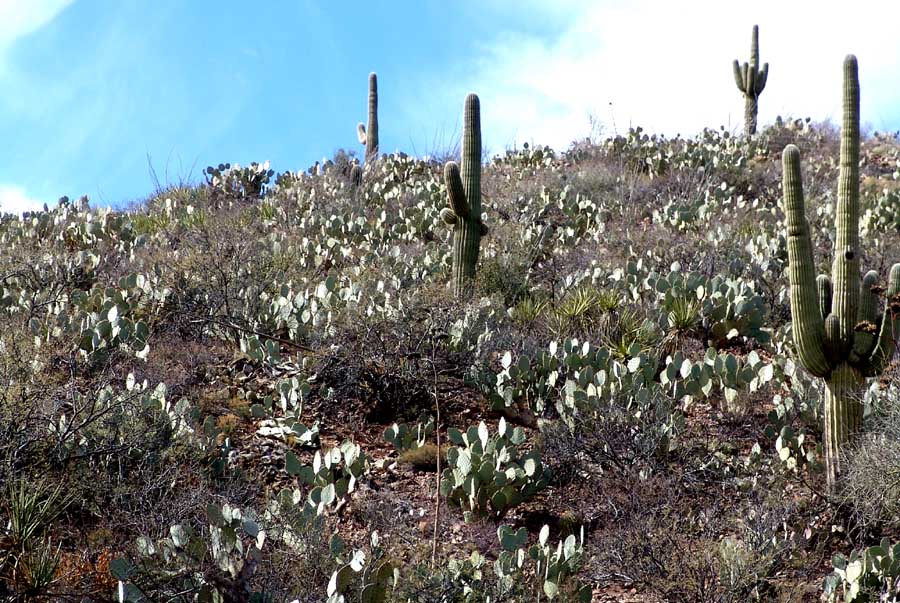
This hillside is directly northeast of Sierra Blanca, and is fairly typical of this area.
Whether alive or dead (as below), masses of Prickly Pear often serve as nests for various kinds of small mammals and reptiles:
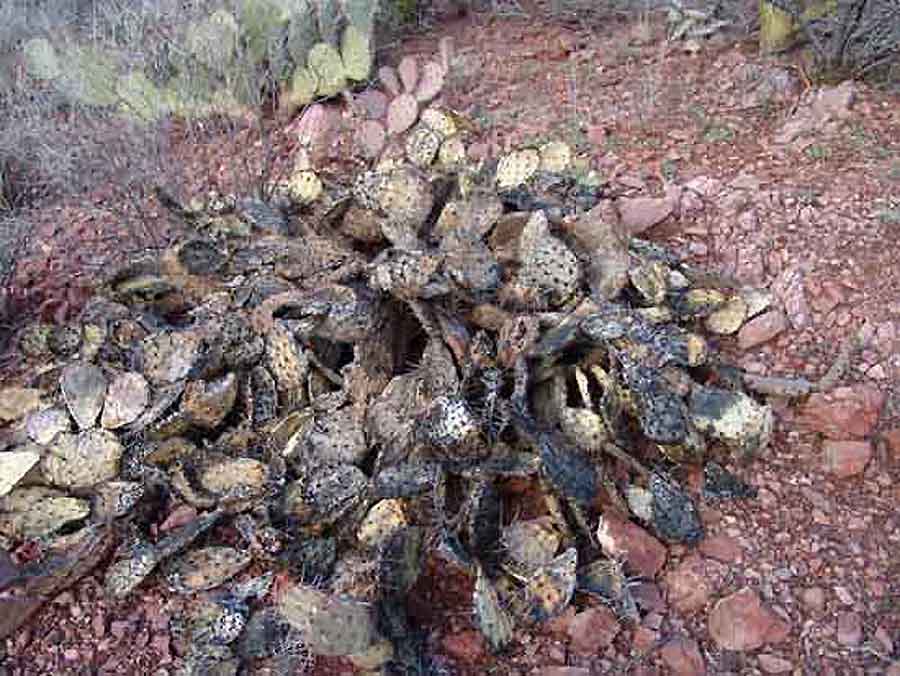
Return to Cacti
